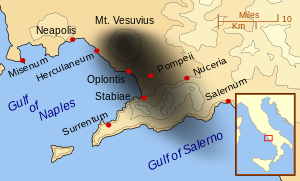
Back Pompeii Afrikaans Pompeji ALS بومبي Arabic بومبى ARZ Pompeya AST Pompey Azerbaijani Помпеи Bashkir Pompéii BAN Пампеі Byelorussian Пампэі BE-X-OLD


Pompeii was an ancient city that was buried by Mount Vesuvius. It is currently a UNESCO World Heritage Site. The preserved site features excavated ruins of streets.
On 24 October 79 AD, a volcano called Mount Vesuvius erupted[1][2] and destroyed the city and its people, killing 2,000 of them. Pompeii is one of the world's most important historical sites because of the way the volcanic ash preserved the city and its people. This gives historians and archaeologists a vivid picture of life in the Roman Empire around 2,000 years ago.
Archaeologists have found graffiti written by the people who lived in the town.[3] People often wrote on walls, and archaeologists have been able to read some of what they wrote.
- ↑ "Archaeological areas of Pompei, Herculaneum and Torre Annunziata". UNESCO. Retrieved 2011-04-02.
- ↑ Wallace-Hadrill, Andrew (2011-03-29). "Pompeii: Portents of Disaster". BBC. Retrieved 2011-04-02.
- ↑ "Uncovering the Graffiti of Pompeii :: Washington and Lee University". wlu.edu. 2011. Archived from the original on February 10, 2011. Retrieved May 5, 2011.
archaeol